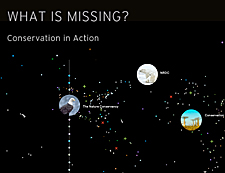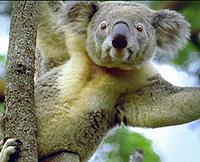In 1981, a Yale undergraduate named Maya Lin was catapulted to global prominence when her design for the Vietnam Veterans Memorial in Washington, D.C., was chosen over 1,441 other entries. Her striking creation — a black stone gash in the earth inscribed with the names of more than 58,000 American soldiers killed in the Vietnam War — remains one of the world’s most moving war monuments.

Now, three decades later, Lin has turned her attention to what she calls her “last memorial” — a global multimedia project aimed at drawing attention to the rapid loss of biodiversity and natural abundance. Centered around an interactive Web site that features more than 75 videos, scores of audio recordings of birds and animals, and photos and text that are an elegy for lost and threatened species, Lin’s “What is Missing?” project has the same arresting, unsettling qualities that are a hallmark of her Vietnam memorial.
In an interview with Yale Environment 360 contributor Diane Toomey, Lin talks about the origins of her What is Missing? project, the media techniques she and her collaborators are using to draw attention to the biodiversity crisis, and the actions that give her hope that we can reverse the tide of nature’s destruction. “I am going to try to wake you up to things that are missing that you are not even aware are disappearing,” says Lin. “If I can get you to look at something afresh, maybe you will pay closer attention.”
Yale Environment 360: So let’s start with an overview of the memorial. It’s multimedia, multi-form, multi-location, and the Web site, What is Missing?, acts as a nexus for the project. So give us the grand tour of What Is Missing?
Maya Lin: I sort of call it my last memorial, but it is a memorial that will basically reinvent [itself]. I love rethinking what things are, changing assumptions — so what if a monument, which we normally think of as being singular and static, can exist in many places simultaneously? Then what if they are not all permanent but sometimes it is a traveling exhibit? One time we borrowed the MTV billboard in Times Square during Earth Day and for a month we played four five-minute videos.
e360 Podcast
Maya Lin talks about her “What is Missing?” project.
We have a Web site that shows you what is going on with the project throughout, but also is its own memorial. And, in fact, the Web site, I would say, is the piece that pulls it all together. It will be a map of the world looked at from an ecological point of view, but it is a map that allows us to see the past, the present, and by 2013 we will be beginning to show you plausible future scenarios, what we call green print, which is really rethinking what the planet could look like. We’ll be talking to many experts [who] focus on agricultural issues to economic issues to environmental issues. It is an experimental artwork, so I don’t know if I’ll ever be finished with it.
And even though I say it is my last memorial, I will be donating to it for the rest of my life. I set up my own not-for-profit foundation, and the goal was to raise awareness about the present crisis surrounding biodiversity loss, link it to habitat loss, and not just be about raising awareness about what we are losing, but maybe using it as a wakeup call, telling you what is being done right now by all the environmental groups, all the experts, but then let’s dream up plausible ways, by 2050, to reimagine what the world could look like. People care. I think they might be a little bit overwhelmed and they might feel helpless. Maybe art could pose the problems and look at possible solutions in a way that is maybe funny at times, maybe a little abstracted at times, trying to just look at it from a different point of view.
e360: For people who haven’t been on the Web site, let’s talk a bit about what we can see and what we can hear there. The main feature is a dark map of the world, and it is populated by many bright dots of various colors, and users click on the dots. Where will they be taken?
Lin: Well, the dots each tell a story about the natural world. Right now there is map of the past and all those dots focus on what we are losing. That includes over 600 historical accounts of abundance of the planet. For

Â
instance, if you clicked on Manhattan, it would jump up and form fifty dots — I call those wormholes. And so we went for the earliest written accounts, from the Dutch settlers, where they found that lobsters were six feet long, oysters were twelve inches in diameter. And as you follow, say, the Manhattan wormhole, as you get further and further along, the rivers degrade, the abundance of wildlife disappears, but then there is an arc of hope. The [1970s] come, the Clean Air Act happens, the Clean Water Act, and all a sudden in present day, in the top of the line of dots, you get to seals returning to the harbor, nature comes back.
e360: The dots that one sees when one goes on the Web site can be sorted in a number of different ways and the user chooses that — by geography, by time, by type of animal. So this is really a self-guided tour in a way…
Lin: Right.
e360: And a visitor to the site is not assaulted with conservation messages. What was the thinking behind that design?
Lin: Well, part of it is like in many of my works, in fact probably all of my works, they are subtle. I mean the Web site right now — and again it is a work in progress — we are simplifying it because we know it is actually a very dense site and it is a little too cryptic. I wanted something that would be subtle, I wanted something you would want to explore. It is very layered but I don’t think there has ever been a place where you could actually look at the ecological history of the planet.
We are inviting experts to come in and help us build a timeline wormhole of England, of London, of all the major cities and all the major waterways as well. [Fisheries biologist] Daniel Pauly named the phenomenon “shifting baselines” and [author] Jared Diamond calls it “landscape amnesia.” We have actually forgotten how abundant the planet used to be and I think if I can pique your memory and make you realize how incredible biodiversity was in your own backyard, then maybe it is going to spur you to action, at which point we also have something on the Web site called “what you can do” — simple things each one of us can do in our everyday lives.
e360: There is a marvelous natural soundscape that greets visitors to the site.
Lin: We have created over 75 one-to-two minute videos and they are playing continuously at the permanent installation out at California Academy of Sciences. We were given an amazing gift through Cornell ornithology labs — they donated all sounds and a lot of video. The BBC as
“What I am really focused on is the diminishment [of] the quality of the planet itself.”
well as National Geographic have also contributed. We are a very visual species, but what if you didn’t see it first but you heard it first. Again, if I can get you to look at something afresh — if I can get you to stop assuming you know what it is, maybe you will pay closer attention. It is about slowing you down, and sound is a way to get you very psychologically and personally connected to a place or a species. The videos blur out at first so you actually can’t tell what you are looking at. The idea is we tease you in a bit and get you to operate almost on a visceral level.
e360: And you have said if you can get people to look differently at the world perhaps they will care more about it. So it is that shift in perspective that you are going for?
Lin: Absolutely.
e360: You recently added new material to the site. It premiered this past Earth Day.
Lin: When you click under “time travel” and you go to the map of the present, we have linked over 40 environmental groups and that list of groups will grow. We are here to invite people in to showcase what is being done, and when you see them all as a family you can begin to say, “Oh, this is what the World Wildlife Fund is doing, this is what the NRDC is doing, this is what Cornell is doing.”
e360: And there is some good news there.
Lin: Yeah, there are some really great successes. Where would we be in this country if we didn’t have the Clean Air Act, the Clean Water Act? There are almost 200 stories of successes over time. So one of the things is just to prove that there have been great gains and great successes, but we have to legislate it, we have to change patterns of our own consumption and how we are treating the planet. We have to raise awareness and educate that there are many ways in which we can turn this around.
e360: And of course these success stories will mitigate that doom and gloom factor that some people may feel when they think about going onto a Web site that is dealing with endangered species.
Lin: Right, or extinct species. I think when most people thought I was doing this they thought it was all about extinct species. And I was like “Well, not really, because we can’t do anything about that.” We can talk about extinction only in terms that it will really wake you up that it is forever when a species disappears. But of course what I am really focused on is the diminishment — the diminishment not just of individual species, but the quality of the planet itself. And whether you are talking about the fact that 40 to 70 percent of declines have occurred in some of our top songbirds in our lifetime, literally that means that the landscape of sounds that we heard as children has changed drastically. So that is missing.

Â
I am going to try to wake you up to things that are missing that you are not even aware are disappearing, because if we can get you to think about something — you know, how can we protect it if we don’t even see it? If I can get you to think of a river in its entirety and tell you the history of that river, like we have done the Columbia River. I am working on one right now for the Thames River in London. These were all places — [for example,] the Chesapeake Bay — when the settlers first came to the New World they were so stunned by how much biodiversity and abundance was there.
e360: In 2010 as part of the What Is Missing? project you traveled to about a dozen countries to ask people what is missing in their personal natural landscape. Tell me a little bit about that trek.
Lin: I was already planning a trip with my family and so I got a camera and as I went around the world I started to ask people, could they tell me what is missing from nature that they have personally witnessed. You began to see that in certain countries people said the same thing. In Mexico, it was the forests. Everyone noticed how rapidly the forests have been deforested and they were really connected to nature in that way. In Peru, it was the frogs. There was a woman who said, “When I was a child I was scared to go out at night because there were so many frogs and they were croaking so loudly, and now there are none.” And you would get to Egypt and Cairo and someone would say, “I miss the night sky’s darkness. I miss seeing the lights of the stars because I can’t see them anymore.” Or a person said in India, “I remember when the butterflies were all over the puddles in the towns and now we have developed it.”
People were very connected in most countries to nature and its diminishment. The interesting thing is that when I got to Southeast Asia and China, they didn’t have as much of a memory, because, say, in China, it has been so long that they actually can’t remember more of a primordial nature.
e360: As part of this memorial you designed something called the “Empty Room” in which videos of endangered species are projected towards the ceiling and visitors capture the images with a piece of plexiglass. This premiered in Beijing. I am wondering if people there responded to this installation in the way that you had hoped.
Lin: Surprisingly, you know I think the average person who experiences a video artwork it’s [for] one or two minutes. [But] they were doing anecdotal time counts and people were staying for 15, 20 minutes. They were just
You might not notice it until it’s too late, and that I think is what we’re coming up against.”
watching all these videos. And it is not just species, it is places, whether it is a mangrove forest or a specific place like the Hoh Rain Forest, which is one of our last pristine rain forests in the [U.S.]. And we were able to make more [videos] that focused on China, whether it is the soft-shelled turtle or sharks, focusing on shark fin soup, many of the animals that were used in traditional Chinese medicine. And again, it [made] people aware that these animals are on the brink of extinction and that just by not eating it you can begin to change [things].
e360: And certainly it is necessary to reach out to non-Western audiences with these messages because a lot of the world’s biodiversity is not in the West.
Lin: Yes, my goal is to have a permanent installation on every continent and that there would be videos custom-made to focus on issues that are very relevant to that continent. So, we don’t have enough on the Middle East, and we definitely need more for Asia and Europe because a lot of what was given to us at the start was more North American in focus. So my goal in the next two to three years is to produce enough of the core videos so that we really have a global outlook, and then the idea would be to distribute free to schools. One of the tenets of What Is Missing? is that it is free as long as you share it.
e360: So for you, Maya Lin, in your personal experience, what is missing?
Lin: Oh my God, everything. The memory I gave was of my hometown, which has stayed basically at the same population of 15,000 and I have watched as one mall went in — it was perfectly fine, but it wasn’t enough — so they built a second mall. And then the first mall goes bankrupt, then they build a third mall, and then they built a fourth mall. I would go back and visit after college and little by little these amazing woods were just gobbled up.
The Sounds of Nature
The What is Missing? Web site features dozens of video and audio clips of species from around the planet.
Listen to the call of a Common Loon:
Hear a prairie chicken’s call:
Listen to the sounds of the Hoh Rainforest in western Washington state:
But I actually think for me, having done a bit of research on this for five years, everything — it is the fish that are disappearing from the oceans, it is the birds — some of our top songbirds are in a 70 percent decline because of habitat fragmentation and suburbanization. Migratory birds are susceptible where they nest and where they end up traveling to for the winter and they are susceptible on their journey. A stationary species you can really see it when it diminishes, [but] if this is a species that travels through the course of the year, some to great distances, and you might not notice until it is too late, and that I think is what we are coming up against. We are not noticing. It is really not about the endangered, threatened, extinct species, because in a way they are so few it is almost too late. It is about the [fact that there were] 65 million pronghorn and now there are 250,000.
Or the fact that the gray wolf was once a robust land mammal and now, oh, we have brought them back in the western [U.S.] states, so there are 250 of them, so now we are allowed to kill off anything above that? I mean I think it is ridiculous. Are we really going to treat the planet as a zoo? I think if I could get you to realize there once were more turtles in the ocean than there were bison, and [look] where they are today — six of the seven species of [sea] turtles are threatened or endangered. Christopher Columbus, when he sailed into the Caribbean, thought he had run aground. He hadn’t. He had run into a sea of turtles.